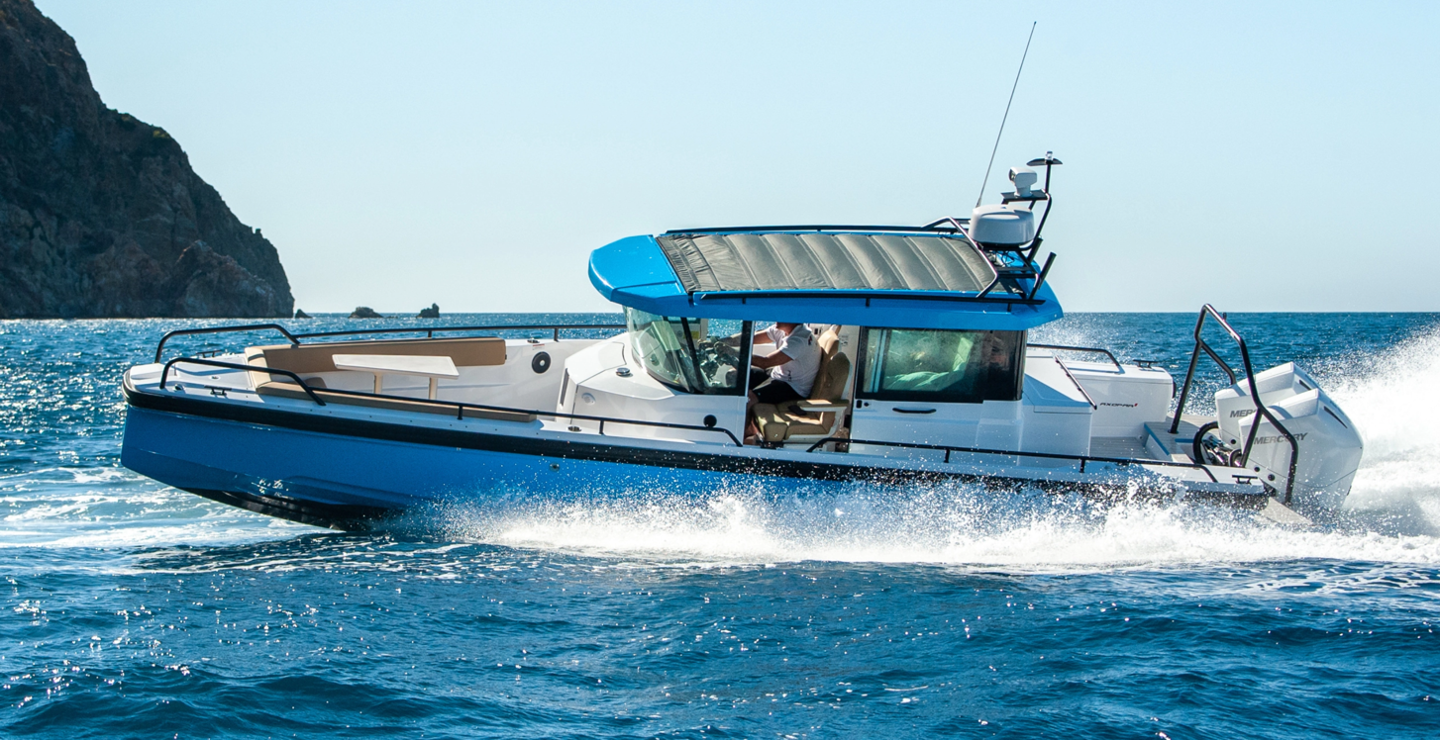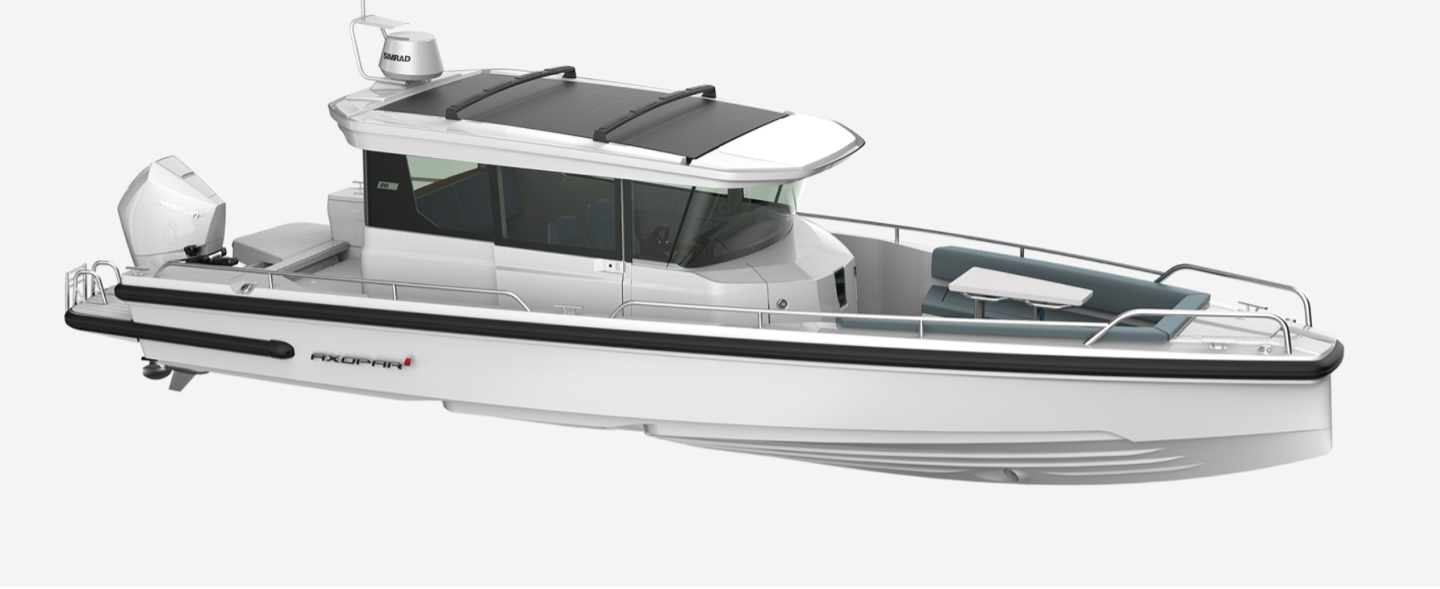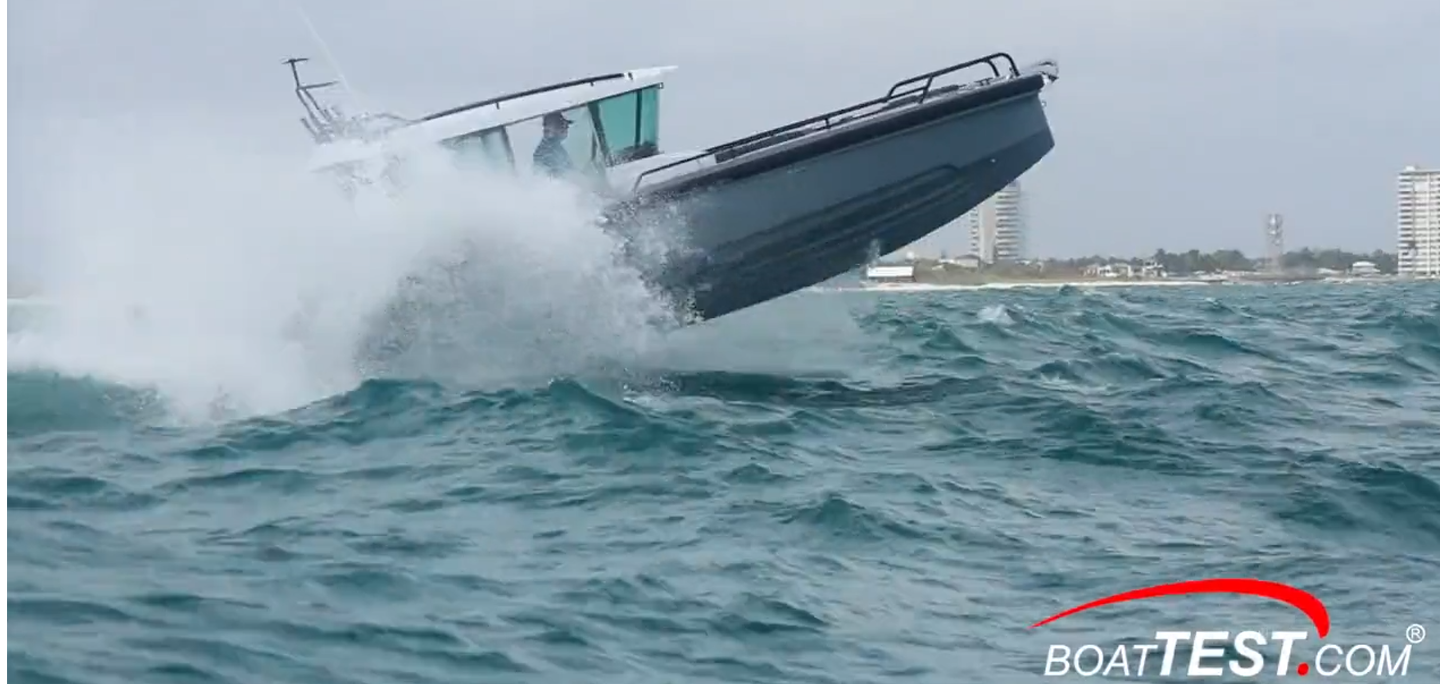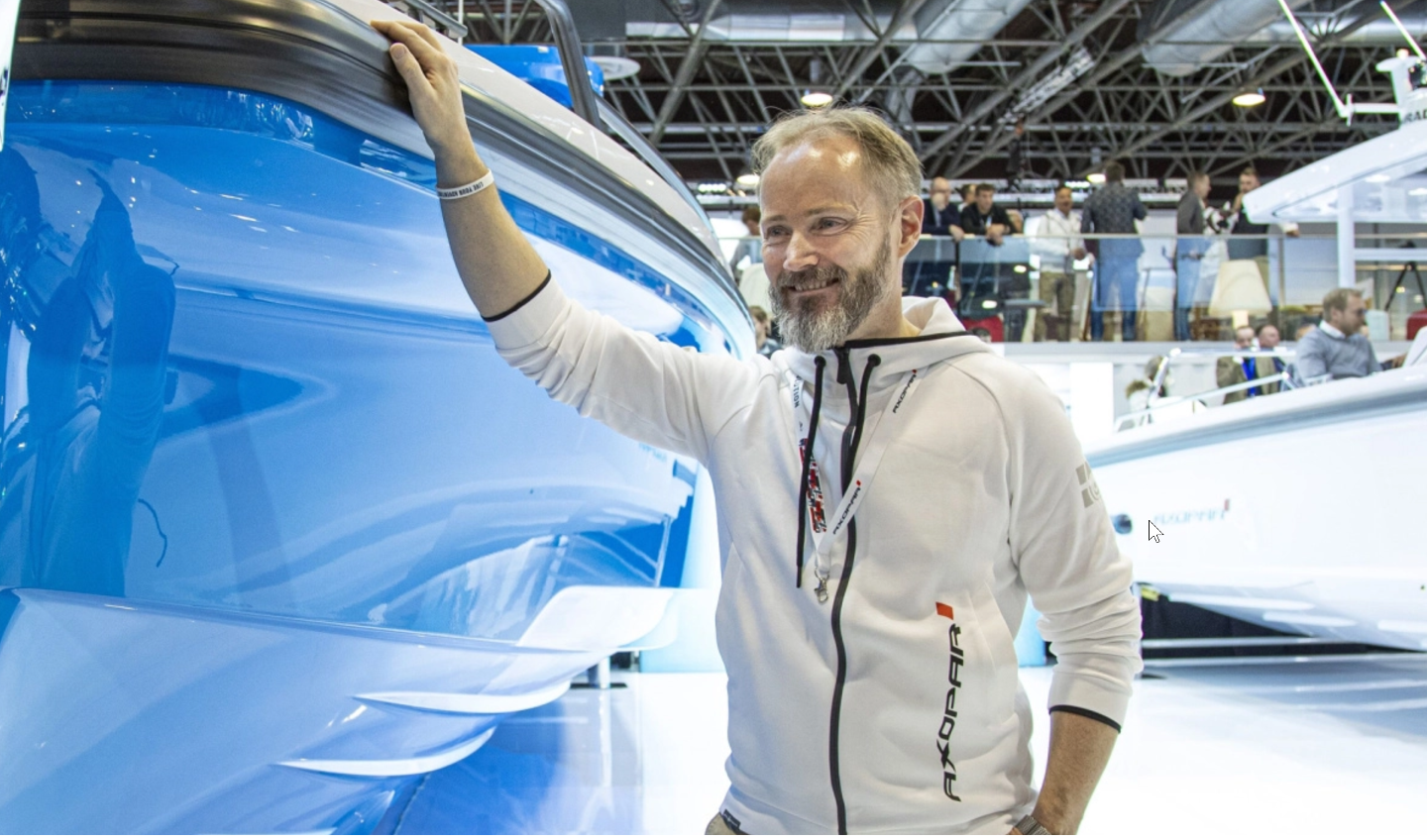The Origin and Narrative Behind Axopar's Concept

BY JEFF HAMMOND
In case you haven’t noticed, there is a strong new design trend that is sweeping the boating world — the Axopar look. It has already been embraced by at least six builders in Europe and now one in the U.S.
When we first saw a picture of the 28 Cabin, we thought it was ugly. That was five years ago. Now, our nautical eye has gotten used to the new profile and we have a completely different take. A huge breath of fresh air has descended from Helsinki, Finland, and swept across the Atlantic to the U.S.
The company is building more than 700 boats a year. All are from five basic hull platforms, upon which three times the number of models are built. All have the same Axopar DNA exhibited in the company's first model — the Axopar 28 Cabin. The boats are remarkably affordable and could inspire many American consumers to rethink how they approach boats.
We recently visited Axopar co-founder Jan-Erik Viitala in Helsinki, Finland. We got a glimpse into the genesis of the brand and the anatomy of the Axopar 28.
Founded in 2012 in Finland, the Axopar management team spent a lot of time and money engineering what would become the Axopar 28 Cabin. The primary goal of the company was to build a boat — and an entire line of boats — that was:
- Seaworthy
- Fuel Efficient
- Affordable
To do that, much thought and engineering had to go into design and manufacturing. The Axopar 28 was the result — a platform that supported three different models and applications.
Axopar co-founders Jan-Erik Viitala and Sakari Mattila, a serial entrepreneur in boat building, were no strangers to the boat industry and how it worked. Because the founders knew what they were doing and where they wanted to go, the brand catapulted from an idea to a successful business in just a couple of years. Mattila left Axopar in 2018 and started another boat brand a year later.

The 28 Cabin was introduced in the spring of 2014. Fifty units were sold in the first 12 months, proving a strong interest in the boat. The 2015 Dusseldorf Boat Show was its first international public debut. People from all over the world saw the boat and many dealers signed on. Sales continued to climb.
By the end of 2019, Axopar had built more than 2,200 boats and had orders for an additional 600. The COVID-19 pandemic only put more pressure on production and boats continued to be backordered into the hundreds. Dealers were put on allocation.
Context of a New Concept
The four Nordic countries of Norway, Sweden, Denmark and Finland, each have a remarkable number of islands near their coastlines. As we cruised through them this summer (on a trip from Oslo to Helsinki), we got the feeling that virtually everyone has a summer cottage, house or mansion on one of the islands.
Number of islands and summer homes by country —
- Norway: 239,057 | 2,000 Inhabited — 440,000 summer houses
- Sweden: 267,570 | 984 Inhabited — 700,000 summer houses
- Denmark: 406 | 70 Inhabited — 200,000 summer houses
- Finland: 178,947 | 780 Inhabited — 500,000 summer houses
Norway, Sweden and Finland have 18%, 15% and 19% household ownership of summer homes, respectively. Denmark trails with just 7%, but it's more than the U.S. — where just 4.4% of households own summer homes. Further, the percent of boat ownership of these Nordic countries per household is the highest in the world.
Axopars are called “commuters” because that is how many of them are used — between work and home or between city dwelling and summer house.
More Context: As a matter of national tax policy, gasoline in European countries has been high for decades by American standards. Therefore, an efficient hull is called for when designing a boat. The price of gasoline this week in Nordic countries per U.S. gallon is—
- Norway: $9.26
- Sweden: $8.65
- Denmark: $9.32
- Finland: $10.06
With prices of fuel nearly double the $4.92 average being charged today (July 3, 2022) in the U.S., fuel efficiency scored high on Axopar’s list of “must-haves.”
Nordic Sea Conditions. It takes little imagination to visualize the possible sea conditions around the islands in the North Sea. Skagerrak between Norway and Sweden is notorious for sloppy conditions. The narrow Kattegat between Denmark and Sweden — where the wind howls as the land creates a venturi effect —actually has the highest average daily wind speed of any of the four countries.
Even in the Swedish and Finnish archipelagos, where the islands break up seas coming from the Baltic and the Gulf of Bothnia, the fetch can be long. This creates challenging and short choppy seas. Any boat that Axopar would build “must have” demonstrable seakeeping abilities.
A Paradigm Shift in Boat Usage
Viitala said it had been clear to him for some time that Nordic boaters were using their vessels less for long cruises and more as dayboats. He marks the tipping point of the evolution from one type to the other around the year 2000. As a result, the Axopar 28 would have to be a versatile boat and appropriate for a multitude of uses such as camping out, fishing, entertaining and cruising. The 28 could be both a commuter and the mother ship for kayaks, paddleboards and windsurfers.
So, another “must-have” for the new Axopar would have to be a high degree of versatility. No one-trick ponies, please.
This is why Axopar’s marketing emphasizes destinations and activities — they have become the boat’s features as much as the electric head or retractable sunroof. By making the boat a means to an end, rather than the end itself, Axopar has invented a new way for the public to look at boats. Axopar boats are not the “sport” itself. They are the means to pursue adventure, outdoor activities and destination travel.
A Boat for Every Purse
The fourth “must-have” for the new Axopar 28 would have to be a good value for money.
“With consumers now using their boats as dayboats, rather than vessels to live on for several weeks at a time during a summer vacation, a $500,000 boat is not so appealing,” said Viitala. “We wanted to have boats that a large number of people could afford around the world.”
To do that, Axopar’s boats would have to sell for far less than the average center console, dual console, bowrider or small cruiser.
As part of the planning process, Axopar’s founders contacted component suppliers and asked for “high-volume” pricing right from the get-go. Some companies chose to play ball and got the business. Now Axopar is selling more boats than any other Nordic boat builder and the vendors’ gamble is paying off.

Axopar uses the same “platform” concept as car makers. Just as Volkswagen, Audi and Porsche have the same frame, so do all of the Axopar models in any one hull size. “Everything below the deck on the Axopar 28 Cabin, Open and T-top are exactly the same,” said Viitala. Axopars are built in two plants in Poland, which have a competitive wage rate and educated, motivated workers.
The company’s production lines for each platform index one position a day at exactly 12 noon. “By having repetitive work, our shop personnel get very good at what they’re doing. So, both quality and speed are attained,” Viitala said.
The last piece of the company’s cost-containment program is the remarkable reduction in fiberglass and resin used in Axopar boats due to their design. More about this is below.
Making the New Concept Fuel Efficient
Starting with a clean piece of paper, the Axopar 28’s engineers started by designing the hull to be efficient, fast, comfortable and seaworthy. RIBs — fiberglass rigid inflatable boats — became the model because they were lightweight. They had excellent seakeeping characteristics, stability and a relatively low cost. Add to that a deck and superstructure and the result was a boat very similar to the small patrol boats used by the USCG.
Low Weight. When we compared the Axopar 28 to dozens of other boats in the BoatTEST database, we discovered that it was the lightest 28-to-30-footer (8.5 m to 9.1 m) we could find. It’s 35% to 40% lighter than well-built center consoles, dual consoles and bowriders we checked and 50% to 58% lighter than cabin boats we checked — all with the same outboard power. The difference in weight is truly remarkable — mostly because all the hulls are hand-laid fiberglass and not infused, except for the new 45.
Axopar lowered the freeboard, used the deck mold to double as a supporting structure for the hull, in addition to the stringer system, and eliminated internal fiberglass liners. This resulted in an astoundingly light boat.
Its wedge shape means that the boat is relatively narrow forward (therefore less material) and does not reach its maximum beam until the transom. Most conventional boats in this size range reach their max beam about one-third of the way back from the stem and then have a nearly straight run aft.
The 28 has a solid fiberglass bottom and is cored above the waterline. With the advent of vinylester, many builders core their bottoms. Axopar’s solid glass bottoms pass the ISO deflection tests and are more puncture-resistant.
Weight and beam are two of the three most critical factors in creating a more efficient boat. The third is a relatively flat bottom. Axopar definitely did not go there because a comfortable ride in sloppy conditions was one of its “must-haves.”
Other details for increasing fuel efficiency —
Double Steps. The 28 has a double-stepped hull that has proven over the years to be more efficient at planing speeds in smooth water. The company believes that it has made major improvements in step design from its CAD work.
Double Chines. They help knock down spray forward and create more stability when at rest or at displacement speeds. When planing, the upper chine is out of the water, thus reducing wetted surface. This makes it easier to push the boat. This is nothing new, but it's a good idea on small and large boats.
Eliminating Unnecessary “Stuff.” Over the last 30 years or so, the world’s best boat builders have continually added more accessories, equipment, expensive materials and design details that have driven the weight and the cost of boats up. They have done this to be more competitive, but costs have spiraled upward.
The Axopar line is somewhat spartan in a Scandinavian way, eschewing frills that don’t add to the utility.
Pricing ranges in the U.S. from about $70,000 (base) for the Axopar 22 Spyder to about $550,000 for the new Axopar 45 that debuted a couple of months ago.
Making the 28 Seaworthy and Comfortable
Not surprisingly for Nordic boaters, seaworthiness is a “must-have.” So it is little wonder that the 28 has a CE “B” rating.
CE “B” Rating with 6 Crew. Boats with this rating must be able to travel up to 200 miles offshore. These boats must be able to handle Force 8 winds (34 to 40 knots) and seas up to 13’ (4 m). For this rating, the boat has to be certified by a qualified inspector and built to ISO standards. The 28 also meets ABYC standards, Viitala said.
Axe Bow. The Axopar’s distinctive plumb bow is designed to slice through waves with its sharp forward edge. When conventional raked bows encounter a wave, they literally slam into it. In doing so the whole boat shudders, or pounds, and slows. The engines must work harder and burn more fuel to climb up and over the waves. The downside is that in sloppy conditions, the Axopar can be wet.
65-Degree Forefoot Deadrise. By having a high deadrise in the forward sections, the Axopar 28 cuts through the seas rather than throwing them out to the side and forward as traditional boats do. While some dynamic lift might be forfeited, the bow always rose to the occasion and showed no tendency to stuff during our tests in 4’ to 6’ (1.2 m to 1.8 m) seas. At the transom, the deadrise is 22 degrees, which is considered a “Deep-V” and cushions the ride.
After his test of the 28 seen in the video above, Capt. Steve said the boat rode “surprisingly well” given his speed and the size of the seas.
Open Stern. All open boats are subject to green water coming aboard in nasty conditions. Once a boat is swamped, it is just a matter of a few seconds or minutes before it capsizes and turns turtle. This is because the transom holds the water in and the scuppers on conventional boats drain little more than rainwater. The free-surface effect capsizes the boat.
While the 28 has a transom that is raised 6” (15 cm) above the deck with port and starboard scuppers, the most important safety factor here for serious dewatering is her open stern.
Low Center of Gravity. By keeping weight low in the boat, minimizing the weight of its superstructure, having double chines and maximizing the boat’s waterline for its length, the 28’s CG is low. This creates stability and enhances sea-keeping abilities. This detail was influenced by RIBs.
Well-Balanced. Many boats in class tend to be stern-heavy, which results in the boat riding on aft sections of its hull where the deadrise is relatively flat. Because the Axopar is well balanced, more of the bottom’s greater V sections are in the water and it provides a more comfortable ride.
Moss-Backed Boaters
“Americans are very conservative when it comes to boats,” Viitala said. We would agree. American-style center consoles are pretty much limited to fishing and bowriders haven’t changed much in function in the last 50 years. Many people have the opinion that the advent of new thinking and new boat designs are long overdue.
Enough Americans seem to have embraced this boat to account for 40% of its worldwide sales.
For the New Generation of Boaters. Viitala told us that right from the start, Axopar boats could be versatile and ready for a new generation of boaters. “They are not interested in boating like their parents and grandparents,” he said. They have less time to recreate and see “our boats as a way to get closer to nature and to be more active,” Viitala said.

Commercial Use of Axopar Boats
“Our boats are increasingly being used for charter,” Viitala said, “and for VIP transfers from a luxury resort to a dinner or island beach location. We’re also seeing them being used as tenders for superyachts with the owner — who is not allowed by the insurance company to drive his multi-million-dollar yacht — take his family off by themselves to visit an island without having a crew around.”
Sovereign Boat Club, which is owned by BoatTEST, is in the process of adding two Axopar 28 Cabins to its growing fleet of up-market boats for members. One boat will be based in Tarpon Springs, Florida and the other in Bradenton, Florida. People are already signing up for memberships in the boats before they arrive.
“We look forward to having more Axopars in our fleet because they will be much easier to maintain than other brands,” said general manager Greg Sweeney. “Axopar has purposely kept problematical and expensive items of equipment off their boats, which makes them a dream for our boat club. We’ll take all of the Axopars we can get.”
“Because the weather is so changeable in south Florida,” Sweeney said, “our members will like the cabin on the 28 where they can duck into during a passing shower. They can also use them as comfortable commuters, for going up and down the coast for overnight stays at hotels and resorts.”
Up-Market Brabus Marine Axopars
Brabus is a German company that specializes in ultra-luxury high-technology car modifications and customizations. They manufacture serial runs of 27 different models, all re-worked Mercedes automobiles. Possibly its most famous project is the Brabus 800 Mercedes-AMG GT 63, which has a 588-hp engine and produces 1,000 Nm of torque. It can go from 0 to 60 mph in 2.9 seconds.
Three years ago, Axopar began a similar partnership with Brabus, which has created its own marine division. Viitala said, “The beauty of this collaboration is that we are now also developing future models together with Brabus so you will see technologies that have been developed by the automobile industry also moving into the boating industry.”
Brabus Marine will be making customized Axopar tenders for superyachts and luxury models for resorts that have their own special needs. By keeping this custom work out of the Axopar factory, it does not disrupt its production rhythm while also not missing a sale.
